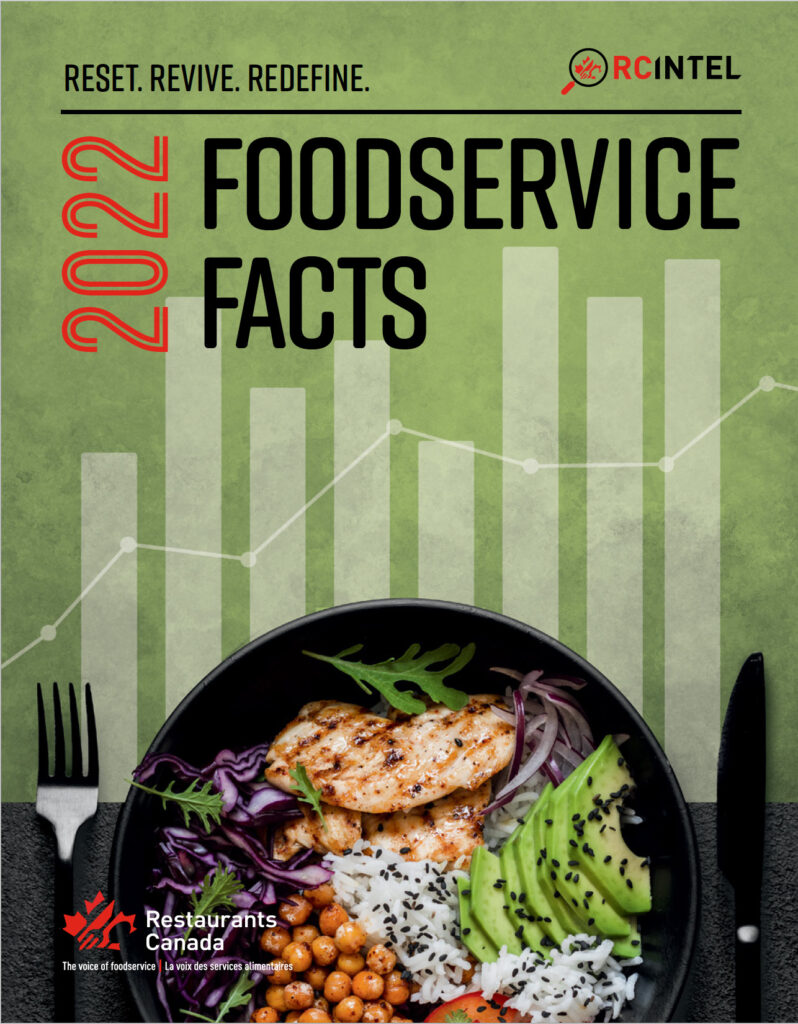Numbers Don’t Lie

Restaurants Canada’s Chief Economist Chris Elliott on this year’s Foodservice Facts report and the stranger things that lie beneath the “return to normal”.
As Chief Economist for Restaurants Canada, Chris Elliott’s year revolves around the research, development and release of Foodservice Facts. The highly anticipated and trusted foodservice industry research and insights guide is designed to capture the economic moment and forecast opportunities and challenges to help guide the industry through the year ahead. The publication kicks off a flurry of media calls and presentations to stakeholders. As the long-term outlook on the recovery of the restaurant sector remains a topic of broad interest and passionate debate, this year’s cycle has been intense.
Coming off three presentations over three hectic days to Restaurants Canada members, media and industry suppliers, Chris sat down with MENU to talk about the big findings and the whitespace within the report. “This is not the presentation I wanted to be giving,” Chris admits. “We had written most of Foodservice Facts, and it was generally positive—things were on the move, things were improving, there was almost that light at the end of the tunnel. In 2022, it seemed the worst was coming to an end after Omicron. But, when we conducted our Restaurant Outlook Survey of our members, and we got the result back, it just flipped everything on its head. As of July, half of our operators were still losing money and were unable to keep up with debt. It was astonishing to see those results. We started digging deeper and realized this was not just a statistical anomaly, this is what’s actually happening in the industry.”
Each year, Chris searches for a familiar, relatable story to add colour and context to the data and insights presented in the report. This year, he found his narrative in the universe popularized by the Netflix blockbuster series, Stranger Things. “How do you present, on the one hand, what looks like a world of “normal” where you walk down Main Street and the patios are full of people and then, on the flip side, you have operators struggling? I was using Stranger Things as an analogy throughout the presentation. It’s a scenario where you have this normal human world, but then on the flipside you have this dark, parallel dimension called “The Upside Down”. So, everything looks normal and positive on the surface, but underneath lies a deep, dark universe where operators are deeply struggling and wondering whether they’re going to survive. What you may see on the surface isn’t necessarily the reality for the restaurant operator.”
Initially Chris had some trepidation about using a theme drawn from popular entertainment culture to convey such heavy data and insights, but feedback from internal and executive presentations has been positive and has even helped bring across the high strangeness of the report findings. “It exactly captures the challenges of what’s happening in the industry. It’s a bizarre world we’re living in.” Any concerns about using the analogy to help stakeholders grasp the implications of the report disappeared during the presentations. “Suppliers are saying they’re using the information to find opportunities for growth. Operators are feeling validated that Restaurants Canada “gets it”. We are corroborating the experience they’re living every day. I think sometimes just hearing that you’re not alone and that others in the industry are struggling just as much can help. They’re not in a panic—they’re tough—but they want some understanding from government that these issues have not gone away. It’s not, “patios are full, so everything’s back to normal”. If traffic is still at 2018 or 2019 levels, that wouldn’t be a bad thing if our food, utility, labour and rent were also still at 2018 or 2019 prices. The problem is that traffic is at 2018-19 levels, but we’re paying these highly inflated 2022 prices. That’s what’s putting new and increased pressure on operators now.”
The report finds that this year’s higher menu inflation represents food and labour costs, with other new supply chain factors adding to the stress on margin management. A shortage in supply and skyrocketing prices for takeout packaging have operators scrambling for new suppliers. “Overall, menu prices are expected to have climbed 7.8 per cent by the end of this year. Typically, we’d see menu inflation at about 2.5 or maybe 3 per cent each year. All those costs that households are paying, restaurant operators are also paying,” Chris acknowledges. “All of the typical expenses operators have always had to manage have gone through the roof. Generally, operators are wary of price increases. They’re now competing directly with grocery stores, so they wouldn’t raise prices if they didn’t have to. They’re raising prices because, if they don’t, they’ll go out of business.”
It was clear from the survey results that operators are taking many steps to minimize menu inflation including cutting back on hours of operation. “The pandemic made already-efficient operators even more efficient,” Chris explains. “This has made them even more efficient. From cutting costs wherever they can to reducing operating hours. The average restaurant is operating at about 80 per cent of their normal capacity.”
How do you present, on the one hand, what looks like a world of “normal” where you walk down Main Street and the patios are full of people and then, on the flip side, you have operators struggling?
Chris Elliott, Chief Economist,
Restaurants Canada
Within the tough conclusions reached in the reports are a few promising insights on the service side of the numbers. “There is a chart showing the results of a survey we conducted with Angus Reid in May where we’d asked consumers – “Yes, we know prices have gone up, but are you seeing value for your money when you go out to a restaurant?”. It was interesting to note that even though the average cheque size for a full-service restaurant is higher than a quick-service restaurant, people responded “excellent” or “good” to the question at a much higher percentage than for quick-service restaurants. This suggests that when people are going out, there’s not just food, there’s also that service, that atmosphere, that experience. As one of our data partners said, “You have to make it a 10/10 guest experience every time every time somebody dines out at your restaurant, so they have that experience and feel like they’re getting their money’s worth.”. Nine out of 10 Canadians say, that when they go out to a restaurant, whether it’s quick-service or full-service, they feel they receive value for money.”
Asked how he feels about his role as the bearer of tough news and the real people behind the statistics derived from the operator survey, Chris points to the comments as a major source of insight on the emotional context of Canadian restaurateurs. “The comments are so revealing in terms of how they’re managing through this crisis—two-and-a-half years into this crisis—and it’s emotional. We ask at the end of the survey, “Are there any other challenges you would like us to know about that we can include?”. That helps us formulate upcoming surveys and how we relay operators interests to government. One operator this year wrote, “Where the [bleep] do I begin?!?”, and literally wrote “bleep”. That’s the type of emotion that’s coming out. They’re overwhelmed…two-and-a-half years into this. Financially they’re very much overwhelmed, and very much scared. Operators are commenting that they’re going to have to take out another loan or cashing out RSPs to save their business. Statistics can’t capture that. When you read that and you know that’s a real operator trying to hold on for dear life and they may lose everything, it changes everything. And that has a bigger impact than the numbers themselves.

Noting that menu consolidation is another inflation management strategy many operators are using, Chris identifies that fewer restaurants are trying to be all things to all people. Building a culture around the whole restaurant that commodifies not only the food, but the complete experience as part of the price. And there may be learning from the chain restaurants for independent and full-service restaurants, particularly in building consistency of experience. “We’ve seen in past economic downturns that people weren’t willing to take a chance on a restaurant they didn’t know versus going to a restaurant that may cost a little more, but at least they know from past experience that it’s going to be good. The consistency is there, there are no surprises. That certainly helped a lot of the chain restaurants during past recessions.
In the future, the development of restaurant social identity and culture will also play a large role in adaptive strategies as the labour gap continues and the possibility of recession waits in the shadows. Building brand-of-place over brand-of-plate can help operators better manage supply chain, food cost and labour challenges by bringing customers into the culture and social values of the restaurant. Customers feel like they are part of and supporting something bigger than a meal and staff feel like the work they do is more meaningful. Chris calls out imPerfect Fresh Eats as an example of a restaurant that incorporates imperfect produce to lower overall costs without sacrificing taste and nutrition. “It’s also part of a larger movement towards sustainability, that is better for the environment by reducing food waste.”
Some relief on the labour gap may also come from the 60+ workforce. While Chris acknowledges that many members of this demographic may be retired and not looking for work, they may be interested in the social proposition afforded by the hospitality sector. “There’s a big group of people over 60 in Canada, but they only represent about eight per cent of the foodservice industry. That’s up from about four percent a couple of decades ago. This demographic has a great work ethic, and they can work during the day as their lives don’t revolve around school hours. I think this is a valuable market to connect with to address labour challenges, perhaps with accommodations like shorter shifts.”
The pandemic has changed lifestyle habits, some perhaps forever. Chris notes that the greatest factor affecting the full return of business in Canadian restaurants has been the shift to remote work within the portable work sector. “The biggest shift in consumer spend is due to hybrid working; people working remotely. According to our survey, about 33 per cent of Canadians who are employed are working entirely or mostly remotely. If you look at that by city, in Ottawa-Gatineau, that number is 60 per cent. I was up there not to long ago and it was a ghost town in the downtown core. There were no lineups whatsoever. Toronto is 44 per cent, but likely much higher in the downtown core.” This phenomenon shows clearly in consumer survey results, with wholly-remote workers reporting that they’re ordering breakfast about 50 per cent less and lunch about 66 per cent less than when they had worked onsite. “When we look at the traffic numbers reported by restaurants, they’re really showing exactly that”, says Chris. “It could be permanent if people continue to work remotely. Breakfast seems to be coming back, but lunch still has a long way to go for both full and quick-service restaurants. On the supper side, people are not going out for dinner after work as much, but they are ordering dinner for takeout and delivery more often if they work remotely than if they don’t. Remote work is having an overall greater negative impact in our industry because it’s impacting dayparts.” While Chris sees some positive gains in supper traffic, they’re mostly felt within the quick-service segment. Delivery remains strong and doesn’t appear to be returning to pre-pandemic levels. As for when (or if) the workforce will return to the office, he feels it’s too early to make that call, but he has faith in the sector to continue to adapt. “Whatever happens, restaurants will respond.”

Not to be left out of the discussion is operator concerns about the possibility of a recession and resulting further changes in consumer behaviour manifesting as fewer restaurant visits. If the worst fears do come to pass, there’s ample precedence to assume that it will hit the lower economic demographics first and hardest, immediately pulling that spend out of market. Higher income earners will also change their behaviour, likely reducing the frequency of their visits, conserving spend for dine-in or special occasions, curtailing spend on breakfast, snacking and lunch occasions. Even then, Chris notes that cheque size will also shrink as consumers forgo more expensive menu options and add-ons like fine wine, appetizers and desserts.
Many operators have given up the waiting game and instead are hyper-focusing on their most profitable daypart, focusing on their core service, what they do best. Chris calls out that the days of endless pivot and trying to cover all bases are at an end for most operators. “At this point, generally operators don’t want to take many more risks. They’re not saying, “Well, we do breakfast really well. Let’s try and capture the supper market.”, and then fail miserably. They’re trying to focus on what they do well. They’re micro-adjusting their business on a weekly basis. Let’s say the price of a certain meat has gone up. Do they raise their prices to try and capture that increased cost or do they try and spread that increase across multiple items. Everyone has to decide the best way to manage it, but there’s no doubt they’re having to do it more frequently.”
Asked to share his thoughts on restaurant formats and features that might help operators meet the challenges of these upside-down times, Chris suggests that an offering somewhere between quick-service and fast casual would be a good place to begin. “It would have a drive-through, the indoor space wouldn’t be as big for on-premise dining, I would have my own window reserved for third-party delivery, and there would be a large digital component to the operation including advance orders to cut wait times and similar efficiencies to take some of the pressures off staff. Maybe not to the point of robots cooking in the kitchen, but certainly technology would have to play a bigger role.”

As the Chief Economist for Restaurants Canada, Chris Elliott manages and produces a comprehensive research program that has made Restaurants Canada a leading source of information for and about Canada’s $95-billion foodservice industry. Chris produces a number of member reports that analyze key industry trends and economic forecasts. Chris has worked with Restaurants Canada for 20 years, has a Bachelor of Arts and Master degree in Economics and specializes in economic modeling and forecasting.
The 2022 Foodservice Facts report is here!
Foodservice Facts is Canada’s most trusted foodservice industry research and insights guide. This special edition of Foodservice Facts looks at how foodservice operators are adapting to survive the unprecedented impact of COVID-19. From the uneven recovery in sales in different segments and provinces, to changing consumer preferences on when and how they dine out, this year’s report provides a detailed analysis of how COVID-19 has shaped and transformed Canada’s foodservice landscape. This year’s report is packed with a variety of industry experts on what key opportunities exist to keep your business running during these turbulent times.
Find Foodservice Facts FREE in the Restaurants Canada Member Portal.
Non-members can purchase a copy on Restaurants Canada Research Page.









